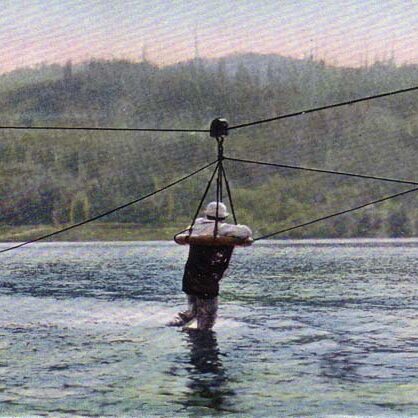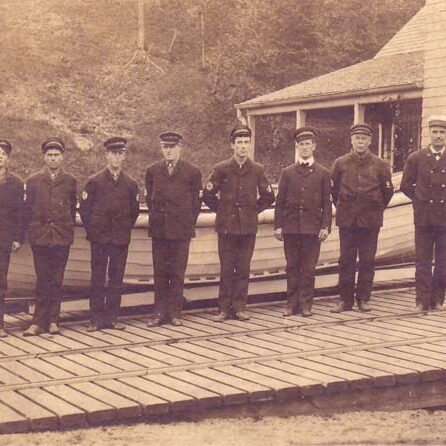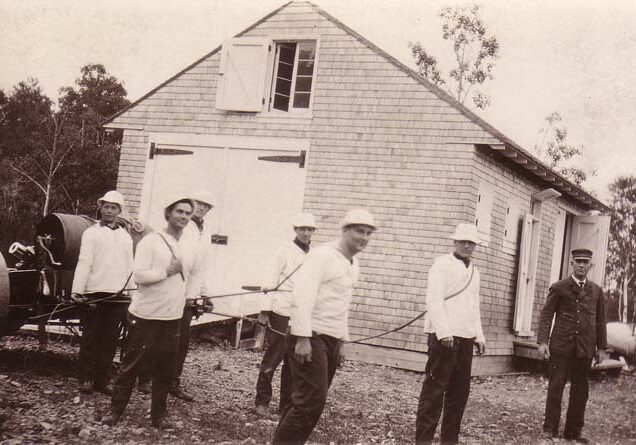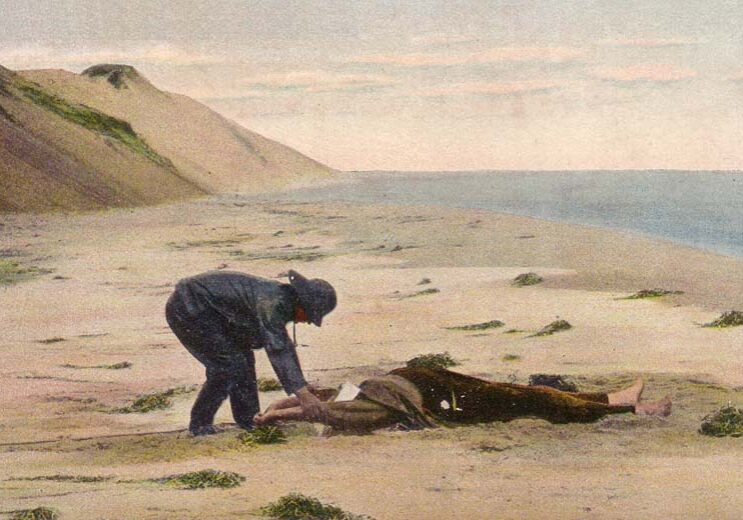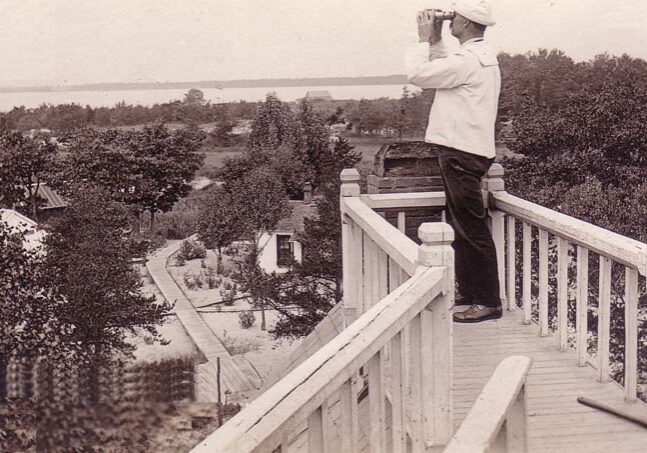Beach Apparatus Drill
The U.S. Life-Saving Service Heritage Association is pleased to offer this complimentary description of the U.S. Life-Saving Service’s Beach-Apparatus Drill published in 1883. Also provided is information on how to properly set up and display a Beach-Apparatus Cart as it would have been set-up per the service’s regulations in this document. Museums and other individuals looking to properly equip or display a beach cart can follow this information to accomplish an accurate display.
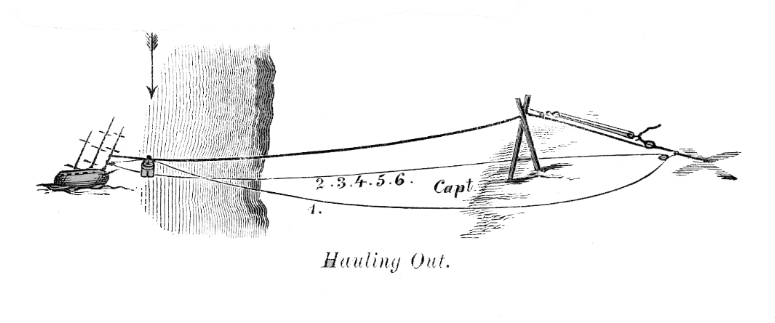
United States Life-Saving Service.
Beach-Apparatus Drill.
BY
LIEUT. C. H. McLELLAN, U. S. R. M.,
ASSISTANT INSPECTOR U. S. LIFE-SAVING STATIONS.
TREASURY DEPARTMENT.
Document No. 420.
Life-Saving Service
TREASURY DEPARTMENT,
Office of General Superintendent U. S. Life-Saving Service,
Washington, D.O., April 3, 1883.
The following system of Beach-Apparatus Drill is promulgated for the information and guidance of the officers and crews of the Life-Saving Service, and will henceforth supersede the drill heretofore employed.
The proper officers will take immediate steps to render the station crews speedily proficient in the exercises of the drill, confining them strictly to the method herein set forth.
S. I. KIMBALL,
General Superintendent.
Approved:
H. F. FRENCH,
Acting Secretary.
BEACH-APPARATUS DRILL.
WORDS OF COMMAND:
"Open boat-room doors-man the beach-wagon."
" Forward."
" Halt."
" Action."
" Man weather w~ip."
" Haul out."
" Man lee whip."
" Haul ashore."
"OPEN BOAT-RoOM DOORS-MAN THE BEACH-WAGON."
Nos. 5 and 6 open and secure the boat-room doors. The captain, 1, 2, 5, 6, and 7 run the boat out of the house, (if necessary,) when the crew will take their stations with the drag- ropes over their shoulders, as shown in· diagram 1.
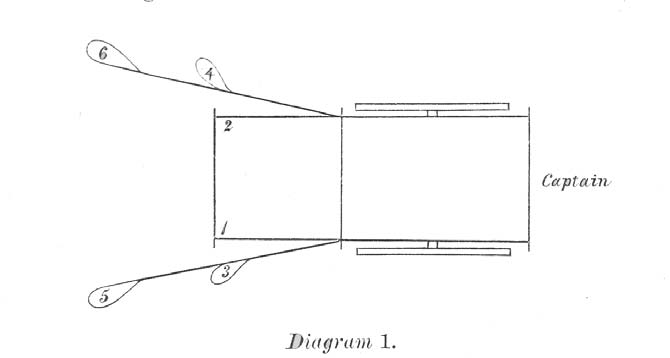
" FORWARD."
The mortar-cart will be taken from the station and to the wreck. When going down the skids or any steep declivity, 1 and 2 will guide the cart while 3, 4, 5, and 6 hold back on the drag-ropes. See diagram 2.
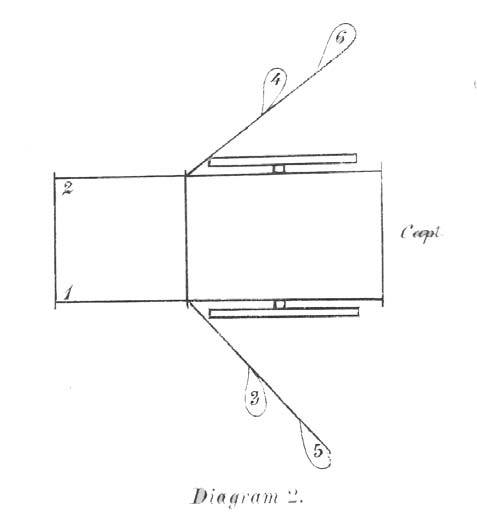
" HALT."
The captain will direct the cart to be placed between the surf and the spot selected for the sand-anchor, and a few yards to windward, (current,) the cart facing the surf. See diagram 3.
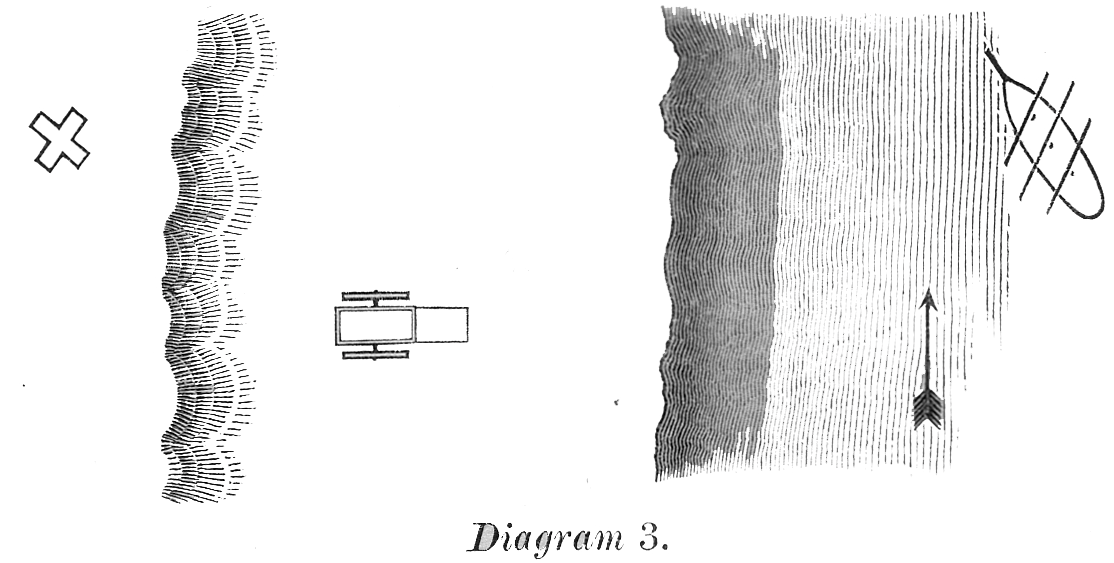
" ACTION."
(Current supposed to be running from the right; wind also from the right.)
Captain puts on his haversack; 4 throws buoy off the cart; 5, 6, and 7 unload the shovel, pick, and sand-anchor, and proceed at once to bury the anchor where directed by the captain; 2 and 3 remove the shot-line box. Captain and 1 remove the gun, and place it in
position four paces to windward of the cart. 2 and 3 place the shot-line box, inverted, on a line with the muzzle of the gun, and three feet to windward, (wind,) unless the wind is directly on shore, when place it to the right, and, after lifting the pins clear of the line, will cant the box in the direction of the wreck.
Captain loads with cartridge, 1 brings the" shot and holds it for the captain to wipe, then inserts it into the bore, forcing it down firmly upon the charge; 2 wets a fathom of the shot-line, and bends it into the shank of the shot with three half hitches, without disturbing the fakes, and without any slack line between the gun and shot-line box.
1 and 2 take position on their knees on the left and right side of the gun, respectively, and train the muzzle to the right or left by the rear handles, as directed by the captain, who· pricks the cartridge, steps two or three yards to the rear, sights over the gun, and commands "Right," "Left," or "Well," as required, giving his orders in a sharp, distinct tone.
The lateral training obtained, due allowance being made for the wind, the captain gives the gun the necessary elevation with the combination level, inserts the primer, bending the loop at a right angle to the tube, hooks the lanyard into the loop, stands off on the weather side, (wind,) gives the cautionary word "ready," and fires.
In the meanwhile 4 unloads and carries the crotch to a point at a suitable distance from the water, on the bluff of the bank, if possible, on a line between the sand-anchor and wreck, and ?pens it wide, span on the left, the legs forming a straight line parallel with the beach, and then carries the breeches-buoy and end of hawser to a point just in front of the crotch.
3 and 4 stretch the tackle from the sand-anchor towards the crotch, (3 at outer block, 4 at inner,) remove the straps, leaving it clear and ready to be placed upon the hawser.
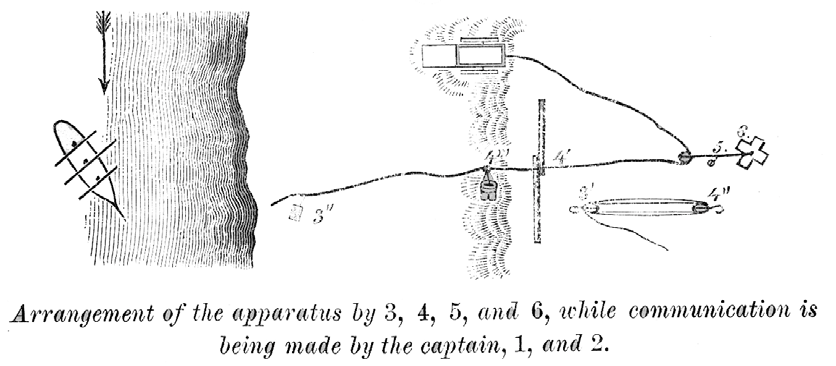
Communication being made with the wreck, 1 takes two half hitches with the shot-line around both parts of the whip, immediately behind the block, while 2 makes a half-hitch over the end of the tail of the whip-block with the bight of the shot-line.
The captain makes a signal to the wreck to haul on board. 1 tends the left and 2 the right part of the whip, separating themselves fifty or more yards. 3 and 4 haul the whip from the reel as fast as needed,3 on the left, 4 on the right. When the tail-block has been made fast on board the wreck, and the shot-line cast off,3 and 4 unreel the whip, the captain, 5, 6, and 7 haul through on the weather (current) part until the line is off the reel; the lee (current) end and weather (current) bight of the whip are taken to the sand-anchor by 3 and 4, where the captain cuts it at the proper length; 4 reeves his end through the lower sheave of the block on the sand-anchor pennant, and the two ends are bent together by 3, using a double fisherman's bend. 1 and 2 bend the lee (current) side of the whip onto the hawser as near the water as possible, 1 holding the hawser three fathoms from the end, while 2 makes a rolling hitch with the bight of the whip around the hawser, the end of the hawser hanging loose; 2, 3, 4, 5, and 7 man the weather (current) part of the whip, and haul off; the captain pays out the hawser. 1 tends lee side of whip, keeping it clear, if possible, from the hawser, which drifts off to leeward of it. 6 hauls the hawser from the cart and lightens it towards the captain, and when the hawser is made fast to the wreck, snatches the bight into the sand-anchor block.
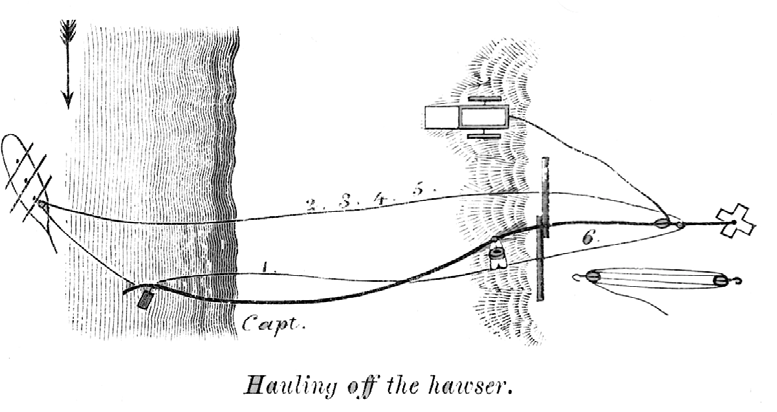
The hawser being made fast on board the wreck, and the whip cast off, land 2 overhaul back the whip until the bend is reached, which the lee man casts off, while the weather man snaps traveler-block onto the hawser, and they then bend ends of whip into the strap of the breeches-buoy block, (1 at the outer, 2 at inner end,) making each end fast with a round turn and two half-hitches; at the same time the captain, and 3, 4, 5, 6,and 7, haul through the slack of the hawser by hand, when 3, 4, 5, and 6 put the tackle on, 3 and 4 at the outer block, 3 with the strap, 5 and 6 at the inner block, 5 making a cat's-paw in the hauling part of the hawser, into which 6 hooks the inner block.
The hawser is then hauled moderately taut by the captain, 1, 2, 3, 4, 5, 6, and 7. 5 takes a turn with the fall, while 3 and 1 at the heel of the left leg, and 2 and 4 at the heel of the right leg, with the captain, 6, and 7 in the center, raise the crotch by raising the center, bringing the heels as near together as necessary; 3 passing and securing the span.
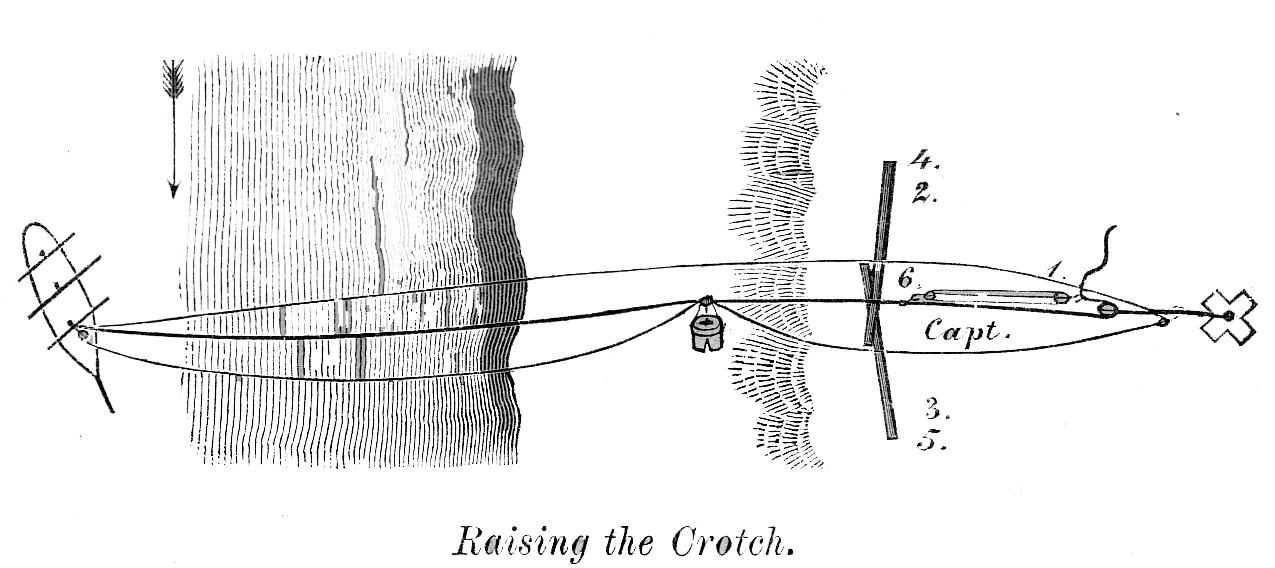
The crotch is inclined outward sufficiently to allow the hawser to be hauled well taut upon its gaining a perpendicular position.
The tackle is again manned, and the hawser hauled taut, when the fall is belayed by 5 around the neck of the inner block; (do not choke the luff,) and the whip is manned.
"MAN WEATHER WHIP"-"HAUL OUT."
1 and 2 have charge of the left and right side of the whip, respectively. 3, 4, 5, 6, and 7 are shifting-men, and man the weather (current) part, and haul the buoy off to the wreck.
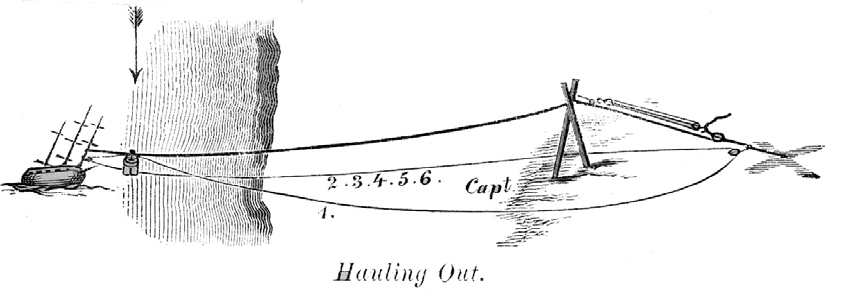
"MAN LEE WHIP"-"HAUL ASHORE."
3, 4, 5, 6, and 7 shift to the lee (current) part of the whip and haul ashore, the captain superintending and assisting where necessary.
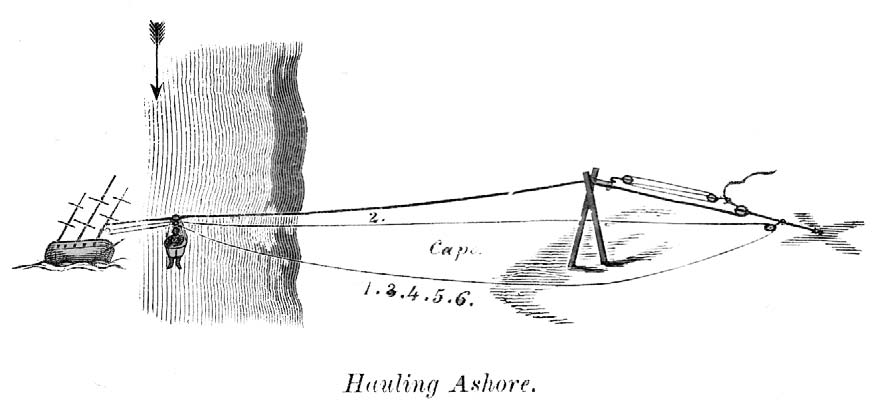
STATION BILL
When practicing, and before giving the command "forward," the captain will muster his crew, and each man, upon his number being called, will salute by touching his hat, and answer as follows:
No. 1.-Place gun in position; provide and load with shot; train the gun; bend the shot-line around the whip inside block; tend the left part of the whip; hold the hawser for 2 to bend on the whip; overhaul back the whip, and if to leeward, unbend ends and bend outer end into traveler-block, if to windward, snap traveler-block onto hawser, and bend outer end of whip into traveler-block; man fall and left leg of crotch.
No. 2.-Place shot-line box in position; bend shot-line into shot; train the gun; take a half hitch with shot-line over tail of whip-block; tend right part of whip; ,bend the lee part of whip onto hawser; overhaul back whip, and if to leeward, unbend ends and bend inner end into traveler block, if to windward, snap traveler-block onto hawser and bend inner end of whip into traveler-block; man fall and right leg of crotch.
No. 3.-Place shot-line box in position; stretch tackle, (outer block;) haul left part of whip from reel; if to windward. reeve end of whip through sand anchor block, otherwise, bend ends of whip together; man weather part of whip when sending off the hawser; haul in slack of hawser; put on strap for outer block of tackle; man fall, left leg of crotch, and am shifting man on the whip.
No. 4.-Unload buoy from cart; place crotch, hawser, and buoy in position; stretch tackle, (inner block;) haul right part of whip from reel; if to windward, reeve end of whip through sand-anchor block, otherwise, bend ends of whip together; man weather part of whip when sending off the hawser; haul in slack of hawser; hook on outer block of tackle; man fall, right leg of crotch, and am shifting man on the whip.
No. 5.-Unload and bury sand-anchor; man the weather part of whip when overhauling off the reel and sending oft' the hawser; haul in the slack of the hawser and make a cat's-paw in the end; man fall; belay fall, and am shifting man on the whip.
No. 6.-Unload and bury sand-anchor; man the weather part of the whip when overhauling off the reel; lighten the hawser to captain; snatch bight of hawser into sand-anchor block; haul in slack of hawser; hook inner block of tackle into cat's-paw; man fall, center of crotch, and am shifting man on the whip.
No. 7.-Unload shovel and pick; assist to bury the sand-anchor; man the weather part of whip when overhauling off the reel and sending off the hawser; haul in slack of hawser; man fall, center of crotch, and am shifting man on the whip.
REMARKS UPON THE EXERCISE.
Odd numbers are on the left, even numbers are on the right when stationed at the hand- cart; and through the exercise, when two numbers work in company, as in training the gun, tending the whip, hauling the whip from the reel, &c., the odd number is on the left, the even number on the right.
The exercise must be considered as a whole, and when a man has performed one duty he will proceed to execute the next assigned him. All must work together. While the captain, 1, and 2 are opening communication with the gun and shot-line, 3, 4, 5, and 6 will have the hawser and its connections ready for sending off and hauling taut.
When practicing, as soon as the gun is discharged, 6 will go to the pole representing the wreck and haul oft' and make fast the whip and hawser, unless some other person willing to perform that duty is present, 4 throws the buoy off the cart that it may not interfere with removing the gun from the cart.
When the individuals of the crew have become expert in the performance of their several special duties, they are, in drill, to be successively transferred, temporarily, to the performance of the duties of each of the other members, until every man becomes proficient in the particular duties of every position. The change is effected as follows: No. 1 to act as captain, the remainder of the crew as stationed at the mortar-cart to move one number with the hands of a watch, the captain acting as 3. The next change, 2, who has been acting No.1, will act as captain, 1 will act as No.3, and the captain as 5, and so on until the circuit is completed.
Before commencing drill the long whip may be removed from the cart, and a whip of about two hundred and fifty yards in length, made from condemned shot-line, and reeled upon a light reel, substituted in its place.
After the men have become familiar with their duties, the captain will note the time it takes to rig the apparatus, commencing from the time the command “Action" is given until No. 6 is landed at the crotch. This time, and the distance of the crotch from the pole, will be noted in the journal.
If through carelessness the shot-line has been faked too tightly upon the pins, instead of forcing it off the pins by the bottom board, which is liable to split, raise the frame and remove a few of the bottom fakes with the hand, when the remainder will fall off into its place in the box.
The sand-anchor must be opened, its sides at right angles to each other, and buried upon its flat in a narrow trench of sufficient depth, say two feet, and the trench filled in solidly about the anchor.
When firing the gun give the lanyard a sharp, strong pull in a direction below the level of the vent, to avoid disturbing the elevation. Prick the cartridge and train the gun upon the wreck before obtaining the elevation, for the same reason.
In many instances, after communication is made with the wreck, as many as two or three hundred yards of shot-line will be left in the box. The captain must be governed by circumstances as to the best method of handling the surplus line. If there is no danger of the wreck going to pieces, the spare line may be hauled on board the wreck, the shore end being bent around the whip; but where great haste is necessary it must be cut.
Bending the bight of the shot-line around the whip is not recommended, as the portion inshore is liable to foul the whip.
Cases may occur when, instead of unreeling the whole whip from the reel, both parts of the whip must be cut as soon as the whip-block is fast on board the wreck. Keepers must act with promptness in such cases, remembering that everything must be sacrificed to save life.
The point where the hawser is best onto the whip must be as far as possible outside of where the ends of the whip are bent together, in order that when the hawser reaches the wreck the whip bend will be well inshore, out of the reach of the shipwrecked people, for should they through excitement or ignorance cast that off instead of the hawser, communication would be broken and much delay result.
The whip should be worked moderately slack, unless extreme cold or drifting ice makes it necessary that it should be kept out of the water.
Instances may occur when the wreck is breaking up rapidly, and there is not sufficient time to send off the whip and hawser, or the crew are too much exhausted to haul the gear off. In such cases, after communication is made by means of the shot-line, cut the shot- line, and bend the shore end onto a single part of the whip; when the end of the whip has reached the wreck, bend the bight of the whip into the slings of the buoy, (block removed,) and let the buoy be pulled off through the surf to the wreck.
Work can be facilitated if, after the gear is set up and in working order, a good man from one of the adjacent crews be sent off in the breeches-buoy to the wreck, who will superintend the work at that end, assisting the people into the buoy, &c.
When more than one crew are present, the adjacent crews will assist at hauling off and setting up the hawser, hauling off and on the buoy, and assisting. the people from the buoy.
Keepers are particularly directed to allow no interference in the management of the apparatus from outside parties, but they may accept their assistance in hauling on ropes, &c.
TO LOAD THE MORTAR-CART.
The crews are not to be exercised in loading the carts expeditiously, but rather in stowing the apparatus compactly, following the instructions, herein contained, explicitly.
The apparatus must be placed upon the cart in the following order:
The reel is unshipped. One man at each corner of the cart and one to lighten it along, proceeds to coil away the hawser, making a Flemish coil, coiling it right-handed from the outside towards the center. Having completed the first layer carry the bight to the outside of the coil and coil toward the center again. Always coil from the outside to the center, so that the hawser, when in use, will run from the center of the coil.
Splice tally-board No.2 into the top end of the hawser permanently, and stow it away in the center of the coil.
Ship the reel and reel the whip upon it as follows: Reeve the whip through the tail-block, make each end of the whip fast with a slight stop at each side of the reel, and reel up, working towards the middle of the spindle; when both parts meet, work back to the end, and so on until the whip is on the reel, when the tail-block will hang in the middle of the whip over the front of the reel.
Splice tally-board No.1 permanently into the tail of the whip-block, just above the splice.
Overhaul the tackle its full length, and place a strap around all parts of the fall, under each block. Place outer block under the reel, on the left side, and coil all parts of the fall, right-handed, around upon the hawser, laying them down flat, leaving off with the inner block under the reel, opposite the first.
Place the gun athwartship the hawser, immediately over the axle, muzzle to the right. Stops, three feet long, are spliced into the top of the sides of the cart-body, and are made fast through the front and rear handles of the right side of the gun-carriage.
Shot-line box A is placed across the cart in the rear of the gun, filling the space between the gun and the tail-board. Stops, three feet in length, are spliced into the top of the sides of the cart-body, and are made fast into the handles of the shot-line box.
The rammer is placed between the gun and shot-line box.
The tail-board is cut away sufficiently on the top under the rails to admit of its being raised to drive two pieces of wood, one-half inch thick, two inches wide, and three feet long, under the tailboard and hawser, one on each side, leaving four inches projecting. The sand-anchor is placed across the rear end of the cart, upon its edge, resting upon these projecting pieces, the bull's-eye pennant hooked into it and moused.
Stops are spliced into the eyes of the tail-board rods and passed down outside of the anchor, around the horns of the cross-frame of the cart-body, back, up outside the anchor, and made fast in the eye again.
The pennant and sand-anchor block are kept up in place by the same stops. The sharp point of the pickaxe is stuck between the sand-anchor and tail-board, on the left side, the handle to the right, the point of the pick resting upon the sand-anchor support.
The loops of the shovel-handles are placed over the upper horn of the pick, blades of the shovel to the right, which are kept in place by a stop spliced around the right rear-brace of the cart-body, and brought up over and around the shovel-handles.
A 3/4-inch hole is bored through both legs of the crotch, at a distance from the bolt equal to the extreme length of the cart. A. span of l-1/2-inch rope, three fathoms long, is spliced into one of these holes. Take a half hitch around both legs with the span, and secure the crotch, under the cart on the left side, making the span fast around the horn of the after, cross-piece of the cart-body, the head of the crotch being made fast at the breast-piece with a two-legged stop spliced there for that purpose.
Place three shot and a heaving-stick and line upon the hawser, in front of the gun, a piece of bagging being placed under them.
Place the haversack, containing four 6-ounce, and four 5-ounce cartridges, filled and marked, and two dozen primers, upon the gun.
The breeches-buoy is laid upon its flat, resting upon the reel and gun. Hang the speaking- trumpet over the left head-board rod.
The gun-worm and axe are hung in leather beckets on the left and right side of the cart- body, respectively.
Over all spread the rubber tarpaulin, stopping it at the corners and sides.
Loaded as above, the reel-stanchions placed six inches from the headboard, the cart should exactly balance. If, through difference in size and weight of crotch and sand- anchor, the cart does not balance, it can be adjusted by moving the gun a few inches forward or aft.
While standing in the house, the cart should have a support under the center of the axle.
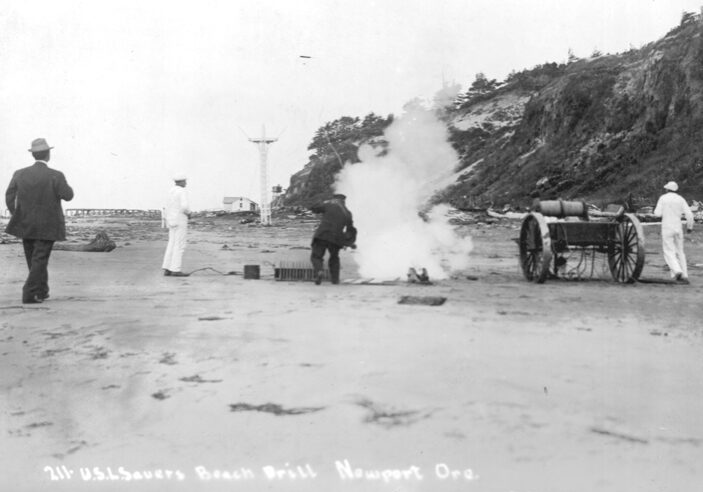
Photo Above and Left: Yaquina Bay. Mondays and Thursdays were reserved for beach apparatus drill. Here the crewmen are setting up a breeches buoy near the Yaquina Bay Life-Saving Station. The keeper is firing a line with a small cannon, called a Lyle gun, towards a pole representing a mast of a stranded vessel 75 yards away. The gun could fire the 17-pound projectile with accuracy up to an extreme range of 695 yards. The life-savers would then erect a series of lines and pulleys to rig the breeches buoy to rescue stranded mariners. A crew was expected to set up the breeches buoy in under five minutes and in the dark. A proficient crew could set it up in two minutes and thirty seconds. (Author’s Collection.)

